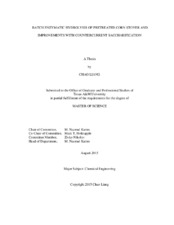| dc.description.abstract | Enzymatic saccharification of non-food biomass, such as lignocellulose, can produce sugars. Sugars are the common feedstock for bioethanol, which can be substituted for transportation fuel and address the shortage of fossil fuels. Traditional batch enzymatic saccharification usually wastes enzymes. An approach is countercurrent saccharification, which can make full use of enzymes and therefore reduce the enzyme loadings and lower the cost of sugar and biofuel production.
In this research, various types of enzymes, enzyme loadings, and pretreatments for corn stover have been studied in batch hydrolysis to determine the preferred reaction conditions for countercurrent saccharification. Based on the results, cellulase CTec3 shows better enzymatic saccharification performance than CTec2 for both raw and pretreated corn stover. For a given enzyme dose, lime pretreatment improves enzymatic digestibility of corn stover significantly. Shock treatment of lime-treated corn stover further increases substrate digestibility. At a CTec3 dose of 10 mg protein/g dry biomass, the glucose yield of lime + shock treated corn stover is close to 100%. In contrast, lime pretreated corn stover yields 85%, and raw corn stover yields only 25%.
For lime + shock treated corn stover, adding additional HTec3 (1 mg protein/g dry biomass) improved both glucose and xylose yields nearly 30% compared to CTec3 (1 mg protein/g dry biomass). The effect of production inhibition on enzyme activity was also tested. When 80 g/L glucose was initially added, glucose and xylose yields decrease 20% and 5%, respectively.
Countercurrent saccharification of lime + shock treated corn stover with enzyme CTec3 (1 mg protein/g dry biomass) and CTec3 (1 mg protein/g dry biomass) + HTec3 (1 mg protein/g dry biomass) was studied. When the systems reached steady state, the Slope Method was used to determine product yields and verify that steady state was achieved. For CTec3 (1 mg protein/g dry biomass), the glucose and xylose yields were 64% and 39%, respectively. For CTec3 (1 mg protein/g dry biomass) + HTec3 (1 mg protein/g dry biomass), glucose and xylose yields were 72% and 62%, respectively.
To reach a given glucose yield (64%), when only adding CTec3, countercurrent saccharification saves nearly 50% of the enzyme loading compared with batch saccharification. To reach a given glucose yield (72%), when adding CTec3 and HTec3 (50%:50%), countercurrent saccharification saves nearly 30% of the enzyme loading compared with batch saccharification.
It requires approximately two months to achieve steady-state countercurrent saccharification. In the future, simulation work is necessary to determine the optimal operating condition. Continuum Particle Distribution Modeling (CPDM) is a potential model to simulate countercurrent saccharification. | en |


